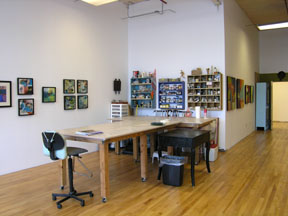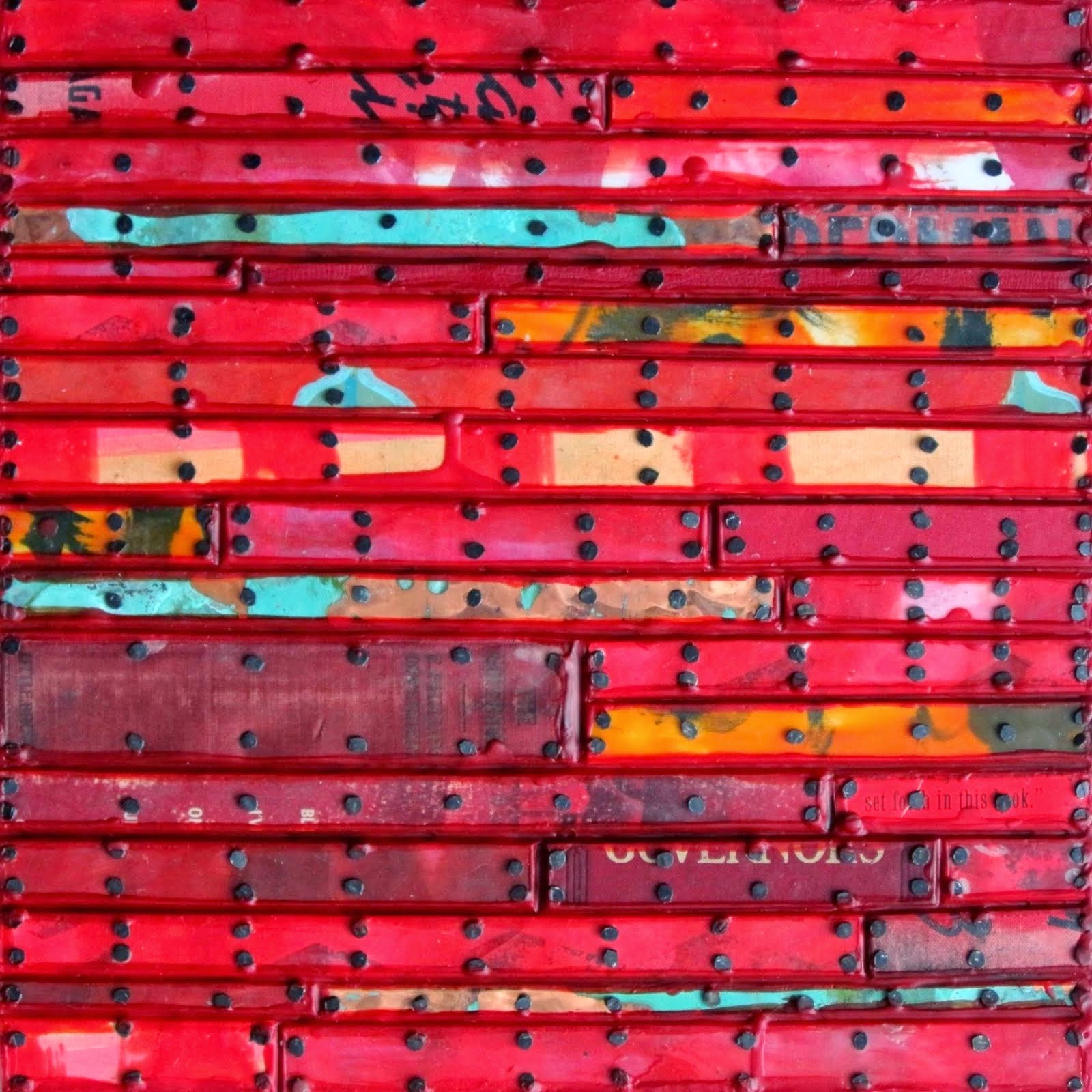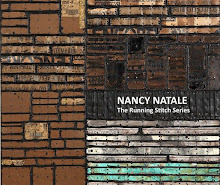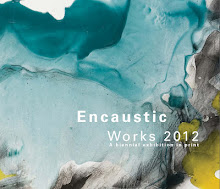The best part of the day for me was the loooong chat about art that Sue and I had coming and going plus the talk at lunch with a few friends from New England Wax.

Left to right: Lynette Haggard, Kim Bernard, Sue Katz, Kellie Weeks, Greg Wright. (A shout out to Kellie and Greg - diligent Art in the Studio readers!)

One of Greg's paintings was chosen to be the predominant image of three on the show card and then selected to appear on the show poster and flag outside the museum. (Greg Wright: Congregation IV, 2007, encaustic on panel, 14"x14".) This work is typical of Greg's intricate and engaging style of painting, and at lunch we discussed where these forms came from (see below).
Children's Art Show at Saco Museum
 Before I get into discussing some of our art conversations and ideas, I just want to mention how impressive the show of children's art was that the Saco Museum had mounted. It was a collaborative installation by area art teachers and a mind-boggling experience to step into the very large back room of the Museum that was just covered with colorful pieces. This was work by Saco-Dayton K-8 students in conjunction with National Youth Art Month.
Before I get into discussing some of our art conversations and ideas, I just want to mention how impressive the show of children's art was that the Saco Museum had mounted. It was a collaborative installation by area art teachers and a mind-boggling experience to step into the very large back room of the Museum that was just covered with colorful pieces. This was work by Saco-Dayton K-8 students in conjunction with National Youth Art Month. 
These photoes only show two sides of the room and don't convey the overwhelming power of multiples demonstrating the various techniques being taught in the schools. I wish I had had time to examine the work more closely.
Were these self portraits? Sometimes I also vizualize myself with a blue nose.

 My favorite exercises in this show were the half-and-half portraits (I'm sure there's a more technical art teacher name for this) where the student cuts in half a black and white portrait of someone and then paints the other half of the face. This is such an intriguing idea.
My favorite exercises in this show were the half-and-half portraits (I'm sure there's a more technical art teacher name for this) where the student cuts in half a black and white portrait of someone and then paints the other half of the face. This is such an intriguing idea. I don't usually look at children's art, not having any little ones of my own, but this was a lot of fun. I hope these art programs don't get cut so that these kids can continue to be excited about creating things.
Art Conversations and the Finer Things
Of course it's impossible to recap 12 hours' worth of art talk, but some of the things discussed included the talk Sue is preparing for the encaustic conference, called "What’s the Big Idea? Discussing Meaning in Our Own Art." Sue will deliver a PowerPoint presentation and then lead a discussion on ideas and processes that generate and propel works. She has been researching for the presentation by interviewing artists about their work and by reading various critics, writers and artists. The discussion of how we make art and what we think about before, during and after art-making continued for some hours and ranged widely.
It continued into lunch, where we talked about why this topic is especially important to artists who paint with encaustic, and here are some reasons why: our medium is new and becoming widely popularized, the technical aspects can be difficult to master and sometimes techniques alone drive works, the medium is popularly misunderstood and misused and, just like any medium, it is used to carry out the intentions of the artist whether the artist formally acknowledges those intentions or not. Sue's talk is intended to address those intentions and get artists to develop and focus on them.
Kim, who is currently in grad school, spoke about how much ideas drive the discussions and critiques of her fellow students and inspire their creation of art. She said that such focus was having a great affect on her own work and causing it to change. A radical change in approach is difficult for artists who have gallery representation, where artists are expected to stick to one consistent look, but we all thought that in the current market, where art sales and representation are so badly affected, there was more room for experimentation and change of style. After all, if nothing is selling, artists can do what they like because sales are not driving their work. We saw this as a good thing in the long run although difficult in the near term.
Then the talk ranged to what inspired us and/or what got us started making art. Some examples: Greg worked as a hair stylist for years. and if you know that, you realize those intricate forms in his work may be related to hair as much as landscape, light or water; Kim's work is inspired by movement and body work and going even more in that direction; I began painting pretty late in life because of the blue shadows I saw on snow and the color I just had to capture; a lot of Sue's work relates to squares doubled into rectangles, as inspired by tatami mats. Kellie told us that her work was full of stories and inspired by them. Lynette said that she was going to take some time in her studio to develop more focus on her work and see what evolved.
Our conversations were fun and inspiring and created bonds of understanding and empathy among us. What's better than a group of artists getting together and talking about art? Not much in my opinion. It's one of the finer things in life.










1 comment:
Now I'm really sad not to have been there for all the art talk. I so enjoy reading your blog.....always.b2
Post a Comment